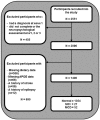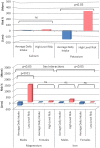Dietary Mineral Intake and Risk of Mild Cognitive Impairment: The PATH through Life Project
- PMID: 24550825
- PMCID: PMC3912433
- DOI: 10.3389/fnagi.2014.00004
Dietary Mineral Intake and Risk of Mild Cognitive Impairment: The PATH through Life Project
Abstract
Background: Higher dietary intake of potassium, calcium, and magnesium is protective against ischemic strokes while also being associated with a decreased risk of all-cause dementia. The effect of dietary iron intake on cerebral function is less clear but iron is also implicated in Alzheimer neuropathology. The aim of this study was to investigate whether dietary intake of these minerals was also associated with increased risk of mild cognitive impairment (MCI, amnestic) and other mild cognitive disorders (MCD).
Methods: Associations between dietary mineral intake and risk of MCI/MCD were assessed in cognitively healthy individuals (n = 1406, 52% female, mean age 62.5 years) living in the community, who were followed up over 8 years. Relative risk was assessed with Cox hazard ratios (HRs) after controlling for health and socio-demographic covariates.
Results: Higher magnesium intake was associated with a reduced risk of developing MCI/MCD (MCI: HR 0.07, 95% confidence interval (CI) 0.01-0.56, p = 0.013; MCD: HR 0.47, 95% CI 0.22-0.99, p = 0.046) in multivariate analyses. Higher intake of potassium (MCI: HR 1.09, 95% CI 1.01-1.17, p = 0.028; MCD: HR 1.05, 95% CI 0.99-1.10, p = 0.107) and iron (MCI: HR 1.54, 95% CI 1.03-2.29, p = 0.034) was associated with an increased risk of developing MCI/MCD.
Conclusion: These findings suggest that dietary intake of minerals known to be implicated in biological processes associated with vascular and Alzheimer's pathology may contribute to disease progression earlier in the disease process and require further attention.
Keywords: calcium; dementia; iron; magnesium; potassium.
Figures


References
-
- American Psychiatric Association (1994). Diagnostic and Statistical Manual of Mental Disorders (DSM-IV). Washington: American Psychiatric Association
-
- Andrasi E., Pali N., Molnar Z., Kosel S. (2005). Brain aluminum, magnesium and phosphorus contents of control and Alzheimer-diseased patients. J. Alzheimers Dis. 7, 273–284 - PubMed
LinkOut - more resources
Full Text Sources
Other Literature Sources

